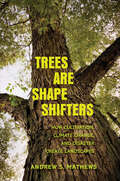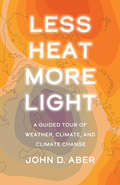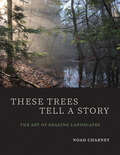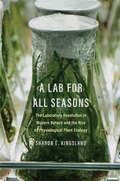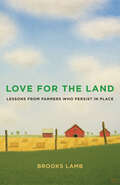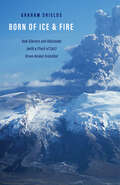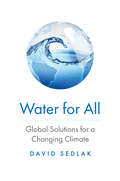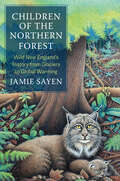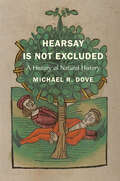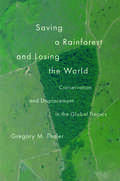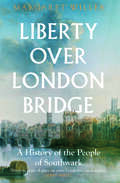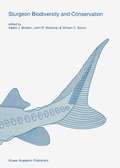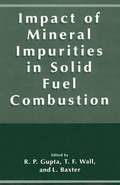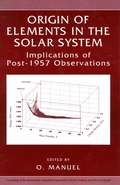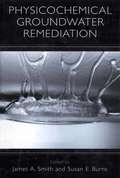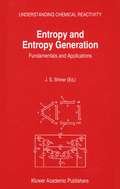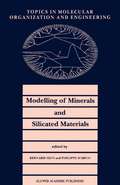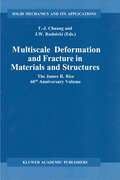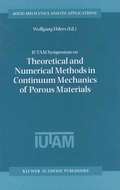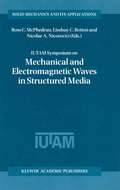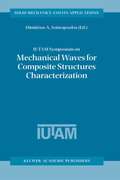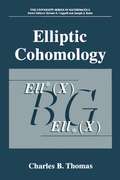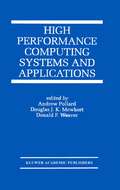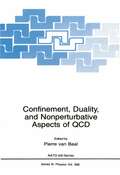- Table View
- List View
Trees Are Shape Shifters: How Cultivation, Climate Change, and Disaster Create Landscapes (Yale Agrarian Studies Series)
by Andrew S. MathewsAn exploration of the anthropogenic landscapes of Lucca, Italy, and how its people understand social and environmental change through cultivation In Italy and around the Mediterranean, almost every stone, every tree, and every hillside show traces of human activities. Situating climate change within the context of the Anthropocene, Andrew Mathews investigates how people in Lucca, Italy, make sense of social and environmental change by caring for the morphologies of trees and landscapes. He analyzes how people encounter climate change, not by thinking and talking about climate, but by caring for the environments around them. Maintaining landscape stability by caring for the forms of trees, rivers, and hillsides is a way that people link their experiences to the past and to larger scale political questions. The human-transformed landscapes of Italy are a harbinger of the experiences that all of us are likely to face, and addressing these disasters will call upon all of us to think about the human and natural histories of the landscapes we live in.
Wild Visions: Wilderness as Image and Idea
by Ben A Minteer Mark Klett Stephen J. PyneA stunning combination of landscape photography and thematic essays exploring how the concept of wilderness has evolved over time Our ideas of wilderness have evolved dramatically over the past one hundred and fifty years, from a view of wild country as an inviolable “place apart” to one that exists only within the matrix of human activity. This shift in understanding has provoked complicated questions about the importance of the wild in American environmentalism, as well as new aesthetic expectations as we reframe the wilderness as (to some degree) a human creation.Wild Visions is distinctive in its union of landscape photography and environmental thought, a merging of short, thematic essays with a striking visual narrative. Often, the wild is viewed in binary terms: either revered as sacred and ecologically pure or dismissed as spoiled by human activities. This book portrays wilderness instead as an evolving gamut of understandings, a collage of views and ideas that is still in process.
Less Heat, More Light: A Guided Tour of Weather, Climate, and Climate Change
by John D. AberA straightforward and fact-based exploration of how weather happens, how it relates to climate, and how science answers major questions about Earth as a system Climate change is one of the most hotly contested environmental topics of our day. To answer criticisms and synthesize available information, scientists have been driven to devise increasingly complex models of the climate system. This book conveys that the basics of climate and climate change have been known for decades, and that relatively simple descriptions can capture the major features of the climate system and help the general public understand what controls climate and weather, and how both might be changing. Renowned environmental scientist and educator John D. Aber distills what he has learned from a long fascination with weather and climate, the process of science, and the telling of the story of science. This is not a book about policies and politics. Instead, it explores how weather happens, how it relates to climate, and how science has been used to answer major questions about the Earth as a system and inform policies that have reversed environmental degradation. By providing a guided tour of the science of weather, this thoughtful survey will contribute clarity and rationality to the public understanding of climate change.
These Trees Tell a Story: The Art of Reading Landscapes
by Noah CharneyA deeply personal master class on how to read a natural landscape and unravel the clues to its unique ecological history Structured as a series of interactive field walks through ten New England ecosystems, this book challenges readers to see the world through the eyes of a trained naturalist. With guided questions, immersive photography, and a narrative approach, each chapter adds layers of complexity to a single scene, revealing the millions of years of forces at play. Tying together geology, forest ecology, wildlife biology, soil processes, evolution, conservation, and more, Noah Charney shows how and why landscapes appear in their current forms. Charney’s stories and lessons will provide anyone with the necessary investigative skills to look at a landscape, interpret it, and tell its story—from its start as rock or soil to the plants and animals that live on it. Ultimately, Charney argues, by critically engaging with the landscape we will become better at connecting with nature and ourselves.
A Lab for All Seasons: The Laboratory Revolution in Modern Botany and the Rise of Physiological Plant Ecology
by Sharon E. KingslandThe first book to chronicle how innovation in laboratory designs for botanical research energized the emergence of physiological plant ecology as a vibrant subdiscipline Laboratory innovation since the mid-twentieth century has powered advances in the study of plant adaptation, evolution, and ecosystem function. The phytotron, an integrated complex of controlled-environment greenhouse and laboratory spaces, invented by Frits W. Went in the 1950s, set off a worldwide laboratory movement and transformed the plant sciences. Sharon Kingsland explores this revolution through a comparative study of work in the United States, France, Australia, Israel, the USSR, and Hungary. These advances in botanical research energized physiological plant ecology. Case studies explore the development of phytotron spinoffs such as mobile laboratories, rhizotrons, and ecotrons. Scientific problems include the significance of plant emissions of volatile organic compounds, symbiosis between plants and soil fungi, and the discovery of new pathways for photosynthesis as an adaptation to hot, dry climates. The advancement of knowledge through synthesis is a running theme: linking disciplines, combining laboratory and field research, and moving across ecological scales from leaf to ecosystem. The book also charts the history of modern scientific responses to the emerging crisis of food insecurity in the era of global warming.
Love for the Land: Lessons from Farmers Who Persist in Place (Yale Agrarian Studies Series)
by Brooks LambA moving exploration of presence and place told through the stories of small-scale farmers who, despite intense adversity, continue caring for their land Love for the Land explores the power and potential of people-place relationships. Through clear and compelling prose, it elevates the virtues of imagination, affection, and fidelity—concepts promoted by farmer-writer Wendell Berry—and shows how they motivate small- and mid-scale farmers to care for the land, even in the face of adversity. Paying particular attention to farmland loss from suburban sprawl, rampant agricultural consolidation, and, for farmers of color, racial injustice, Brooks Lamb reckons with the harsh realities that these farmers face. Drawing from in-depth interviews and hands-on experiences in two changing rural communities, he shares stories and sacrifices from dozens of farmers, local leaders, agricultural service providers, and land conservationists. Lamb’s rural roots and farming background enable him to cultivate honest, trusting connections with the farmers he engages, yielding raw and powerful insights. Time and again, compelling evidence reveals that stewardship virtues encourage people to live and act as devoted caretakers. With a refreshing, accessible, and engaging approach, Lamb argues that these resilient and often overlooked farmers show rural and urban people alike a way forward, one that serves people, places, and the planet. That path is rooted in love for the land.
Born of Ice and Fire: How Glaciers and Volcanoes (with a Pinch of Salt) Drove Animal Evolution
by Graham ShieldsAn exploration of how the Cryogenian Period, when our planet was covered in ice for millions of years, created today’s remarkable biodiversity More than half a billion years ago, our world was completely covered by glaciers, a “Snowball Earth” that persisted for millions of years. Incredibly, this unimaginable cold led to the remarkable diversification of life on earth known as the Cambrian explosion. With a geologist’s eye and a knack for storytelling, Graham Shields explores when and how such inhospitable conditions enabled animals to evolve, radiate, and diversify into our earliest ancestors. This journey navigates the wild swings between hot and cold climates, oxygenation and asphyxiation, biological radiations and extinctions, asking how such instability relates to grander forces that brought our planet to its modern state. Shields guides readers through evidence found in the Australian outback, Mongolia, Scotland, and other locales, revealing how geologists can trace glaciation, the atmosphere, oceans, mountain building, and more through the earth’s rocks, providing a comprehensive theory of how life evolved and diversified.
Water for All: Global Solutions for a Changing Climate
by David SedlakA fresh look at the world’s water crises, and the existing and emerging solutions that can be used to solve them It is not your imagination: water crises are more frequent. Our twentieth-century systems for providing the water that grows food, sustains cities, and supports healthy ecosystems are failing to meet the demands of growing population and the challenges brought on by climate change. But the grim news reports—of empty reservoirs, withering crops, failing ecosystems—need not be cause for despair, argues award-winning author David Sedlak. Communities on the front lines of previous water crises have pioneered approaches that are ready to be applied elsewhere. Some have resolved shortages by enhancing water-use efficiency, and others have used moments of crisis to resolve historic disagreements over water rights. Still others have employed treatment technologies that unlock vast quantities of untapped water resources. Sedlak identifies the challenges that society faces, including ineffective policies and outdated infrastructure, and the myriad of tools at our disposal—from emerging technologies in desalination to innovations for recycling wastewater and capturing more of the water that falls on fields and cities. He offers an informed and hopeful approach for rethinking our assumptions about the way that water is managed. With this knowledge we can create a future with clean, abundant, and affordable water for all.
Children of the Northern Forest: Wild New England's History from Glaciers to Global Warming (Yale Agrarian Studies Series)
by Jamie SayenThis no-holds-barred narrative of the failure of conservation in northern New England’s forests envisions a wilder, more equitable, lower-carbon future for forest-dependent communities Jamie Sayen approaches the story of northern New England’s undeveloped forests from the viewpoints of the previously unheard: the forest and the nonhuman species it sustains, the First Peoples, and, in more recent times, the disenfranchised human voices of the forest, including those of loggers, mill workers, and citizens who, like Henry David Thoreau, wish to speak a kind word for nature. From 1988 to 2016 paper companies sold their timberlands and closed seventeen paper mills in northern New England. Policy makers ceded veto power to large absentee landowners, who tried to preserve the status quo by demanding additional tax cuts and other subsidies for economic elites. They vetoed measures designed to restore and preserve forest health; at present, about half of the former industrial forests are classified as degraded, and the regional economy continues to be trapped in low-value commodity markets. This book operates as a case study of how a rural resource region can respond to a global economy responsible for climate change, habitat loss and degradation, and environmental injustice. Sayen offers a blueprint for restoring vast wildlands and transitioning to a lower-carbon, high-value-adding, local economy, while protecting the natural rights of humans, nonhumans, and unborn generations.
Hearsay Is Not Excluded: A History of Natural History (Yale Agrarian Studies Series)
by Michael R. DoveThis chronicle of natural history argues that the modern environmental crisis and rise in science skepticism codeveloped with the rise of ever narrower scientific disciplines For millennia, the field of natural history promoted a knowledgeable and unifying view of the world. In contrast, the modern rise of narrow scientific disciplines has promoted a dichotomy between nature and culture on the one hand and between scientific and folk knowledge on the other. Drawing on the fields of anthropology, history, and environmental science, Michael R. Dove argues that the loss of this historic holistic vision of the world is partly to blame for contemporary environmental degradation and science skepticism. Dove bases this thesis on a study of four pioneering natural historians across four centuries: Georg Eberhard Rumphius (seventeenth century), Carl Linnaeus (eighteenth century), Alfred Russel Wallace (nineteenth century), and Harold C. Conklin (twentieth century). Dove studies their field craft and writing; the political, cultural, and environmental circumstances in which they worked; the sources of their insight; and the implications of their work for modern society. Most of all, the book seeks to discover what enabled those natural historians to straddle boundaries that today seem impassable and to distill that wisdom for a modern world greatly in need of a holistic vision of people and environment.
Saving a Rainforest and Losing the World: Conservation and Displacement in the Global Tropics (Yale Agrarian Studies Series)
by Gregory M. ThalerAn unflinching investigation of the false promises of land sparing, exposing how its illusory successes mask the failures of green capitalism For two decades, the concept of land sparing, the claim that agricultural intensification can spare land by preventing forest clearing for agricultural expansion, has dominated tropical forest conservation. Land sparing policies transform landscapes and livelihoods with the promise of reconciling agricultural development with environmental conservation. But that land sparing promise is false. Based on six years of research on agrarian frontiers in Indonesia, Brazil, and Bolivia, this book traces where and how land sparing becomes policy and charts the social and ecological effects of these political contests. Gregory M. Thaler explains why land sparing appears successful in some places but not in others and reveals that success as an illusion achieved by displacing deforestation to new frontiers. The failure of land sparing exposes a harsh truth behind assurances of green capitalism: capitalist development is ecocide.
Liberty over London Bridge: A History of the People of Southwark
by Margaret WillesThe first complete history of Southwark, London’s stubbornly independent community over the Thames Southwark’s fortunes have always been tied to those of the City of London across the river. But from its founding in Roman times through to flourishing in the medieval era, the Borough has always fiercely asserted its independence. A place of licence, largely free of the City’s jurisdiction, Southwark became a constant thorn in London’s side: an administrative anachronism, a commercial rival, and an asylum for undesirable industries and residents. In this remarkable history of London’s liberty beyond the bridge, Margaret Willes narrates the life and times of the people of Southwark, capturing the Borough’s anarchic spirit of revelry. Populated by a potent mix of talented immigrants, religious dissenters, theatrical folk, brewers, and sex workers, Southwark often escaped urban jurisdiction—giving it an atmosphere of danger, misrule, and artistic freedom. Tracing Southwark’s history from its Roman foundation to its present popularity as a place to visit, through Chaucer, to Shakespeare, and on to Dickens, Willes offers an indispensable exploration of the City’s unacknowledged mirror image.
Sturgeon biodiversity and conservation (Developments in Environmental Biology of Fishes #17)
by Vadim J. Birstein John R. Waldman William E. BemisSelected, reviewed and revised papers from the International Conference on Sturgeon Biodiversity and Conservation held at The American Museum of Natural History in New York on 28-30 July 1994
Impact of Mineral Impurities in Solid Fuel Combustion
by R. Gupta T. Wall L. BaxterThis book contains papers presented at the Engineering Foundation Conference on mineral matter in fuels held on November 2-7, 1997 in Kona, Hawaii. The conference is one of a continuing series that was initiated by the CEGB Mar- wood Engineering Laboratories in 1963. The conference was to be eventually organised by the Engineering Foundation as the need for multi-disciplinary work related to c- trolling ash effects in combustors became apparent. The conference covers both the science and the applications. The papers also present case histories, particularly for current fuel technologies, developments in advanced technologies for power generation and mathematical modelling of these processes. Developments since 1963 have been slow, but steady, due to the complexity of the chemical and physical processes involved. However, the research presented here displays great improvement in our understanding of the mechanisms by which mineral matter will influence fuel use. Steve Benson from EERC presented a review and current status of issues related to ash deposition in coal combustion and gasification. The application of new analytical tools, which have been detailed in the previous conferences, is presented. These include CCSEM, as well as new techniques for char- terising sintering of ash, such as TMA, image analysis, X-ray diffraction crystallography and thermal analysis. The new analytical techniques were extended to encompass widely differing fuels such as biomass. Ole H Larsen from ELSAM Denmark presented a review of these advanced techniques.
Origin of Elements in the Solar System: Implications of Post-1957 Observations
by Oliver K. ManuelBased on an American Chemical Society Symposium organized by Professors Glenn Seaborg and Oliver Manuel, this volume provides a comprehensive record of different views on this important subject at the end of the 20th century. They have assembled a blend of highly respected experimentalists and theorists from astronomy, geology, meteoritics, planetology and nuclear chemistry and physics to discuss the origin of elements in the solar system. The intent was to include all points of view and let history judge their validity.
Physicochemical Groundwater Remediation (Aids Prevention And Mental Health Ser.)
by James A. SmithAs we transition into the 21st century, it is apparent that this is an exciting time for environmental engineers and scientists studying remediation technologies. There has been a rapid development of new ways to clean-up polluted groundwater. Research activities of the past and next 10 years will have a dramatic impact on the quality of the subsurface environment for the next century. In 20, or even 10 years from now, our approach to subsurface remediation will probably be vastly different than it is today. Many of the emerging technologies presented in this book will form the basis of standard remediation practices of the future. Physicochemical Groundwater Remediation presents detailed information on multiple emerging technologies for the remediation of the contaminated subsurface environment. All of these technologies apply our knowledge of physical and chemical processes to clean up ground water and the unsaturated zone, and many (if not all) of these emerging technologies will help define standard practices in the future. These technologies include in situ sorptive and reactive treatment walls, surfactant-enhanced aquifer remediation, optimization analyses for remediation system design, chemical, electrochemical, and biochemical remediation processes, and monitored natural attenuation. You will learn how palladium catalyzes the dehalogenation of chlorinated solvents. You will find out how barometric pumping can naturally remove significant quantities of volatile organic pollutants from shallow ground water and the unsaturated zone. You can learn about mobilizing non-aqueous phase liquids (NAPLs) without risking significant downward migration of the NAPL. You can find out how processes such as electroosmosis and electromigration can be exploited for groundwater remediation purposes and how zero-valent iron and zeolite treatment walls can be used in situ to treat and control contaminant plume migration. Contributors to this book are experts in groundwater remediation processes, and they represent industry, consulting, academia, and government. If your work involves the clean up of contaminated soil and groundwater, this book is an essential reference to keep you up to date on the most promising new developments in remediation research.
Entropy and Entropy Generation: Fundamentals and Applications (Understanding Chemical Reactivity #18)
by J. S. ShinerEntropy and entropy generation play essential roles in our understanding of many diverse phenomena ranging from cosmology to biology. Their importance is manifest in areas of immediate practical interest such as the provision of global energy as well as in others of a more fundamental flavour such as the source of order and complexity in nature. They also form the basis of most modern formulations of both equilibrium and nonequilibrium thermodynamics. Today much progress is being made in our understanding of entropy and entropy generation in both fundamental aspects and application to concrete problems. The purpose of this volume is to present some of these recent and important results in a manner that not only appeals to the entropy specialist but also makes them accessible to the nonspecialist looking for an overview of the field. This book contains fourteen contributions by leading scientists in their fields. The content covers such topics as quantum thermodynamics, nonlinear processes, gravitational and irreversible thermodynamics, the thermodynamics of Taylor dispersion, higher order transport, the mesoscopic theory of liquid crystals, simulated annealing, information and biological aspects, global energy, photovoltaics, heat and mass transport and nonlinear electrochemical systems. Audience: This work will be of value to physicists, chemists, biologists and engineers interested in the theory and applications of entropy and its generation.
Modelling of Minerals and Silicated Materials (Topics in Molecular Organization and Engineering #15)
by B. Silvi P. D'ArcoThe modeling of minerals and silicated materials is a. difficult challenge faced by Solid StatePhysics, Quantum Chemistry and Molecular Dynamics communities. The difficulty of such a modeling is due to the wide diversity of elements, including heavy atoms,and types of bonding involved in such systems. Moreover, one has to consider infinite systems: either perfect cr- tals or glasses and melts. In the solid state a given chemical composition gives rise to numerous polymorphs, geometricallycloselyrelated. These polymorphs have very similar energies and related thermodynamical pr- erties which explain the complexity of their phase diagrams. The modeling of silicates and minerals covers a wide field of applications ranging from basic research to technology, from Solid State Physics to Earth and Planetary science. The use of modeling techniques yields information of different nature. In the case of chemical studies, we can mention inv- tigations on catalytic processes occurring on surfaces and in zeolite cages. These calculations find possible applications in chemical engineering, in particular in the oil industry.
Multiscale Deformation and Fracture in Materials and Structures: The James R. Rice 60th Anniversary Volume (Solid Mechanics and Its Applications #84)
by T. J. Chuang J. W. RudnickiModern Solid Mechanics considers phenomena at many levels, ranging from nano size at atomic scale through the continuum level at millimeter size to large structures at the tens of meter scale. The deformation and fracture behavior at these various scales are inextricably related to interdisciplinary methods derived from applied mathematics, physics, chemistry, and engineering mechanics. This book, in honor of James R. Rice, contains articles from his colleagues and former students that bring these sophisticated methods to bear on a wide range of problems. Articles discussing problems of deformation include topics of dislocation mechanics, second particle effects, plastic yield criterion on porous materials, hydrogen embrittlement, solid state sintering, nanophases at surfaces, adhesion and contact mechanics, diffuse instability in geomaterials, and percolation in metal deformation. In the fracture area, the topics include: elastic-plastic crack growth, dynamic fracture, stress intensity and J-integral analysis, stress-corrosion cracking, and fracture in single crystal, piezoelectric, composite and cementitious materials. The book will be a valuable resource for researchers in modern solid mechanics and can be used as reference or supplementary text in mechanical and civil engineering, applied mechanics, materials science, and engineering graduate courses on fracture mechanics, elasticity, plasticity, mechanics of materials or the application of solid mechanics to processing, and reliability of life predictions.
IUTAM Symposium on Theoretical and Numerical Methods in Continuum Mechanics of Porous Materials: Proceedings of the IUTAM Symposium held at the University of Stuttgart, Germany, September 5–10, 1999 (Solid Mechanics and Its Applications #87)
by Wolfgang EhlersDuring the last decades, continuum mechanics of porous materials has achieved great attention, since it allows for the consideration of the volumetrically coupled behaviour of the solid matrix deformation and the pore-fluid flow. Naturally, applications of porous media models range from civil and environmental engineering, where, e. g. , geote- nical problems like the consolidation problem are of great interest, via mechanical engineering, where, e. g. , the description of sinter materials or polymeric and metallic foams is a typical problem, to chemical and biomechanical engineering, where, e. g. , the complex structure of l- ing tissues is studied. Although these applications are principally very different, they basically fall into the category of multiphase materials, which can be described, on the macroscale, within the framework of the well-founded Theory of Porous Media (TPM). With the increasing power of computer hardware together with the rapidly decreasing computational costs, numerical solutions of complex coupled problems became possible and have been seriously investigated. However, since the quality of the numerical solutions strongly depends on the quality of the underlying physical model together with the experimental and mathematical possibilities to successfully determine realistic material parameters, a successful treatment of porous materials requires a joint consideration of continuum mechanics, experimental mechanics and numerical methods. In addition, micromechanical - vestigations and homogenization techniques are very helpful to increase the phenomenological understanding of such media.
IUTAM Symposium on Mechanical and Electromagnetic Waves in Structured Media: Proceedings of the IUTAM Symposium held in Sydney, NSW, Australia, 18–22 January 1999 (Solid Mechanics and Its Applications #91)
by Ross C. McPhedran Lindsay C. Botten Nicolae-A. P. NicoroviciThe IUTAM Symposium on Mechanical and Electromagnetic Waves in Structured Media took place at the University of Sydney from January 18- 22, 1999. It brought together leading researchers from eleven countries for a week-long meeting, with the aim of providing cross-links between the com- nities studying related problems involving elastic and electromagnetic waves in structured materials. After the meeting, participants were invited to submit articles based on their presentations, which were refereed and assembled to constitute these Proceedings. The topics covered here represent areas at the forefront of research intoelastic and electromagnetic waves. They include effect of nonlinearity, diffusion and multiple scattering on waves, as well as asymptotic and numerical techniques. Composite materials are discussed in depth, with example systems ranging fromdusty plasmas to a magneto-elastic microstructured system. Also included are studies of homogenisation, that field which seeks to determine equivalent homogeneous systems which can give equivalent wave properties to structured materials, and inverse problems, in which waves are used as a probe to infer structural details concerning scattering systems. There are also strong groups of papers on the localization of waves by random systems, and photonic and phononic band gap materials. These are being developed by analogue with semiconductors for electrons, and hold out the promise of enabling designers to control the propagation of waves through materials in novel ways. We would like to thank the other members of the Scientific Committee (A.
IUTAM Symposium on Mechanical Waves for Composite Structures Characterization: Proceedings of the IUTAM Symposium held in Chania, Crete, Greece, June 14–17, 2000 (Solid Mechanics and Its Applications #92)
by Dimitrios A. SotiropoulosThis book is a collection of selected reviewed papers that were presented at the International Union of Theoretical and Applied Mechanics Symposium "Mechanical waves for composite structures characterization". The Symposium took place June 14-17, 2000 in Chania, Crete, Greece. As is customary, IUTAM Symposia Proceedings are published in the series "Solid Mechanics and Its Applications" by Kluwer Academic Publishers. I am indebted to Professor G. M. L. Gladwell who is the series editor. I would also like to take this opportunity to express my sincere gratitude to Professor M. A. Hayes the Secretary General of the International Union of Theoretical and Applied Mechanics and a member ofthe Symposium's Scientific Committee. His constant encouragement and support made the Symposium not only possible but also successful. To the success also contributed all the members of the Symposium's Scientific Committee which I had the honor to chair. I express my appreciation to each one of them who are: Professor J. D. Achenbach (Northwestern University, Evanston, Illinois, USA), Professor M. A. Hayes (University College, Dublin, Ireland), Professor K. J. Langenberg (University of Kassel, Germany), Professor A. K. Mal (University of California, Los Angeles, USA), Professor X. Markenscoff (University of California, San Diego, USA), Professor S. Nair (Illinois Institute of Technology, Chicago, USA), Professor R. W. Ogden (University of Glasgow, UK), Professor G.
Elliptic Cohomology (University Series in Mathematics)
by Charles B. ThomasElliptic cohomology is an extremely beautiful theory with both geometric and arithmetic aspects. The former is explained by the fact that the theory is a quotient of oriented cobordism localised away from 2, the latter by the fact that the coefficients coincide with a ring of modular forms. The aim of the book is to construct this cohomology theory, and evaluate it on classifying spaces BG of finite groups G. This class of spaces is important, since (using ideas borrowed from `Monstrous Moonshine') it is possible to give a bundle-theoretic definition of EU-(BG). Concluding chapters also discuss variants, generalisations and potential applications.
High Performance Computing Systems and Applications (The Springer International Series in Engineering and Computer Science #541)
by Andrew Pollard Douglas J. K. Mewhort Donald F. WeaverHigh Performance Computing Systems and Applications contains the fully refereed papers from the 13th Annual Symposium on High Performance Computing, held in Kingston, Canada, in June 1999. This book presents the latest research in HPC architectures, distributed and shared memory performance, algorithms and solvers, with special sessions on atmospheric science, computational chemistry and physics. High Performance Computing Systems and Applications is suitable as a secondary text for graduate level courses, and as a reference for researchers and practitioners in industry.
Confinement, Duality, and Nonperturbative Aspects of QCD (Nato Science Series B: #368)
by Pierre Van BaalProceedings of a NATO ASI and Isaac Newton Institute Workshop held in Cambridge, UK, June 23-July 4, 1997
